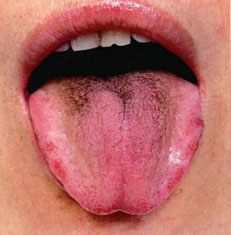Body colour: pale.
Body shape: swollen, central Heart crack, transverse Spleen cracks on the sides.
Coating: thin-white (normal), slightly yellow in the centre.

The pale tongue-bocolour indicates Yang deficiency (it also indicates Blood deficiency, but in a man, it is more likely to be Yang deficiency). It is not possible from the tongue only to establish which organ is mostly affected in this case by the Yang deficiency: however, since the tongue body is also swollen, which usually indicates Phlegm, it is more likely to be Spleen-Yang deficiency. The central crack in this case correlates with the Heart.
A "Heart crack" is rather thin and long, extending from near the root of the tongue to near the tip; a "Stomach crack" is rather wide and is situated only in the middle section of the tongue, in the Stomach area. What does a Heart crack indicate? It depends on its depth and on the colour of the tongue tip. Generally speaking, a Heart crack indicates a constitutional propensity to Heart patterns and to emotional problems: the deeper the crack, the stronger this propensity. If, in the presence of a Heart crack, the tongue tip is red, it indicates that there already is a Heart pattern usually from emotional problems. In other words, a change in colour of the tongue body indicates that that particular constitutional tendency to Heart patterns has manifested itself and generated an actual Heart pattern. If we compare two people both with a red tip of the tongue, one with a Heart crack and the other without, the presence of a Heart crack indicates that that person has a constitutional tendency to Heart patterns and that his or her condition is deeper and more difficult to treat than that of the person without a Heart crack.
The small, transverse cracks on the sides usually indicate severe, chronic Spleen deficiency. Thus, we can conclude that this man suffers from a chronic Spleen-Yang deficiency and Phlegm.







